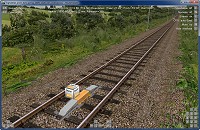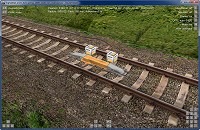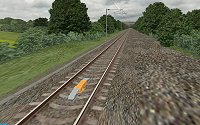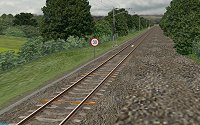- [WJ-R]: 1980s object removal (Castlethorpe/Hanslope area)
- [XCS]: Pending
- [UkTrainSys]: v0.3.2.0 released
- [Object Library]: Preparing...
- [Website]: Fifth version of website launched
 My openBVE videos and other comments from users and
myself can also be found via my YouTube
channel.
My openBVE videos and other comments from users and
myself can also be found via my YouTube
channel.Blog and Progress Updates
December 25, 2010
openBVE v1.2.10 released, Cross-City South v1.31.11 update, and UkTrainSys v0.3.1.9 now available, with enhanced AWS and TPWS simulation, diesel multiple unit support, and various improvements
Posted by admin on December 25, 2010 at 11:15 pmopenBVE v1.2.10 released
![]() openBVE has now reached v1.2.10, which marks the first stable release to feature cross-platform .NET support. This is great news for non-Windows users, who can benefit from the extended functionality, system simulation, and the AI support feature which new .NET plugins can provide. Please head over to the official openBVE homepage to download the latest stable release, as well as to read about the latest developments. Also, don’t forget to read the changelog, for a summary of various other changes which have taken place since v1.2.8.2.
openBVE has now reached v1.2.10, which marks the first stable release to feature cross-platform .NET support. This is great news for non-Windows users, who can benefit from the extended functionality, system simulation, and the AI support feature which new .NET plugins can provide. Please head over to the official openBVE homepage to download the latest stable release, as well as to read about the latest developments. Also, don’t forget to read the changelog, for a summary of various other changes which have taken place since v1.2.8.2.
openBVE users who also use my Cross-City South v1.31 route, should also note that the route is now updated for the new version of openBVE, and it also requires the latest version of the new UkTrainSys plugin for full simulation the class 323’s safety systems to be available, because I’ve now altered the route’s .Beacon commands to take full advantage of the enhanced realism of the new UkTrainSys AWS and TPWS implementation. More details can be found below…
UkTrainSys v0.3.1.9 now available, with enhanced TPWS and AWS simulation, diesel multiple unit support, and a few other enhancements
![]() I’ve just released the next version of the UkTrainSys cross-platform plugin, which is now up to version 0.3.1.9. This latest release includes initial support for diesel multiple units. Other new features include the Vigilance Device reduced cycle time, far more realistic AWS and TPWS simulation, and several other improvements. Here follows some more information about the various features:
I’ve just released the next version of the UkTrainSys cross-platform plugin, which is now up to version 0.3.1.9. This latest release includes initial support for diesel multiple units. Other new features include the Vigilance Device reduced cycle time, far more realistic AWS and TPWS simulation, and several other improvements. Here follows some more information about the various features:
Diesel engine support:
UkTrainSys now has diesel engine support, which means that the plugin can be used with trains which rely on Simon Gathercole’s UKSpt.dll, such as Sprinters or the class 170 (although diesel locomotives are supported too, apart from ammeters and wheelslip protection – I’ll add these later). I’ve decided to recreate much of Simon’s complex diesel engine model, rather than the simple model. This means that UkTrainSys includes the requirement to hold the engine starter button down until the engines are running, as well as simulating the starter motor, and a percentage likelihood that the engine will stall on starting. I’ve also adapted the AI Support feature, so that the AI driver can start the diesel engine, even if it stalls, as well as restart the engine if it is shut down at any point.
Vigilance device with reduced cycle time:
It’s now possible to set an option within the UkTrainSys.cfg file, which enables the Vigilance Device reduced cycle time of 45 seconds, when the power notch is 6 or 7.
Miscellaneous changes:
Firstly, I’ve now implemented a solution for the infamous anomalous multiple-arm phenomenon, which a few people have commented on, when openBVE’s AI driver is enabled for the first time in a driving session. You shouldn’t see any weird, freaky stuff going on in the cab any more, provided that you don’t look over your shoulder, at least. 😉
Secondly, when traction power is not meant to be available, openBVE’s internal reverser position is now set to neutral, whereas previously, only the power handle was set to zero. This means that regenerative braking is disabled when passing through a neutral section, for example.
Thirdly, I’ve also expanded the range of optional Data values which can be recognised via .Beacon 50 commands. UkTrainSys can now be informed of an upcoming terminal station, and this instructs the UkTrainSys AI Support implementation to leave the reverser alone after stopping, so that UkTrainSys and openBVE aren’t continually squabbling over their respective desires where the reverser handle position is concerned. .Beacon 50 can now also be used to instruct the AI Support to lower the pantograph or stop the diesel engine upon the next station stop, after the doors have opened. .Beacon 50 can also be used to inform UkTrainSys of an upcoming neutral section, now. As UkTrainSys will implement a tap changer in future, and a tap changer can take over 30 seconds to run down to notch 0, this beacon can be placed quite some distance ahead of a neutral section. When this neutral section beacon instruction is encountered, UkTrainSys begins monitoring the train’s speed, along with the distance to the neutral section, and decides when exactly to return the power handle to notch 0. UkTrainSys also checks to see if the tap changer is enabled or not, and if it is, the time taken to run down the tap changer is taken into account.
Lastly, the AI guard and related beacons, have been expanded to accommodate multiple stopping points at a station, and UkTrainSys selects which beacon to act upon, depending upon how many cars the player’s train has.
Train Protection and Warning System (TPWS):
For this release, I’ve also significantly increased the realism of the Train Protection and Warning System (TPWS) implementation. With Simon’s previous generation of plugins written for BVE 4, the TPWS simulation seemed to be realistic to the end user, but it didn’t always work in a way which truly reflects how the real TPWS works. Thanks to openBVE, as well as openBVE’s API and documentation, I’ve been able to create a TPWS simulation which works just like the real thing, while also being backwards compatible with routes which were written with Simon’s BVE 4 plugins in mind.
For example, the implementation of the Overspeed Sensor System in Simon’s plugin, was a simplification of how the real OSS works. Simon’s plugin recognises the optional Data parameter of a single .Beacon 44002 or .Beacon 44003 command, as a maximum permissible speed. If the train’s speed exceeds the set speed which is encoded in the .Beacon command’s Data parameter, then the TPWS issues an OSS brake demand. This simplified system works well enough, however it doesn’t take acceleration or deceleration curves into account, for example, and it’s not how the real system works. My OSS implementation, works exactly like the real system.
UkTrainSys recognises a track mounted OSS as comprised of a pair of induction loops (beacons) – the arming loop, and the trigger loop. Where Simon’s plugin expects to read a set speed from only the trigger beacon, UkTrainSys can read a unique frequency from each beacon’s optional Data parameter instead. The permissible OSS set speed, is now determined by the distance between the induction loops, just like in reality. Furthermore, UkTrainSys implements a pair of on-board OSS timers, and the OSS timeout period can be set in the UkTrainSys.cfg file, to suit a passenger or freight train – there is no need to edit a route file to accommodate both types of train. Each timer acts independently of the other, being armed by different arming frequencies, and this allows for realistic nesting and interleaving of induction loops, as well as realistic system behaviour when travelling backwards over induction loops.
The Trainstop Sensor System (TSS) implementation has also been made more realistic. With Simon’s plugins, a single beacon acts as the TSS installation, but with the real system, a pair of induction loops form the TSS – as with the OSS, there is an arming and trigger loop. UkTrainSys recognises TSS arming and trigger induction loops based upon frequencies specified via the optional Data parameter of the .Beacon commands. When the plugin encounters a TSS arming beacon, one of two TSS detection states is activated, and only if a TSS trigger beacon with a suitable frequency is encountered while the arming beacon is still within “detection range”, will the TSS be functional. If a TSS trigger beacon is encountered without an arming beacon having activated the system, then the trigger beacon is ignored, as with the real system. Again, this means that induction loops can be nested and interleaved, and prototypical reverse direction behaviour can be simulated.
Automatic Warning System (AWS):
I’ve not only improved the realism of the TPWS simulation, but I’ve also implemented a more realistic implementation of the Automatic Warning System (AWS), as well. With Simon’s previous generation of BVE4 plugins, and the routes designed for use with them, a single beacon command is used to represent an AWS magnet. The new UkTrainSys AWS simulation also supports this legacy behaviour, but UkTrainSys can also now respond to an AWS permanent magnet, together with an AWS electromagnet. Both are defined via separate .Beacon commands, with a distinction between the magnetic polarity of the magnets defined via the optional Data parameter. This allows for a fully realistic AWS simulation, using only one beacon type, whether associated with a signal or a speed restriction.
When UkTrainSys encounters an AWS permanent magnet, the AWS is primed, the AWS sunflower instrument goes black, and a timeout period is started. If an energised AWS electromagnet is detected within this timeout period, then an AWS clear is issued (i.e. the bell/bing sound, and the sunflower instrument stays black). If no electromagnet is detected within the timeout period, then an AWS warning is issued when the timeout period expires, just like with the real AWS. This also allows for a slightly more realistic simulation of the AWS when travelling at very low speed over an AWS magnet associated with a signal showing a green aspect. At very low speeds, the AWS can be primed by the detection of the permanent magnet, but the timeout period can expire before the electromagnet is detected, which leads to an AWS warning being issued, even though the signal is green (Simon’s plugins also simulate this). However, with UkTrainSys, if you don’t cancel the AWS warning, it will actually clear itself when the electromagnet is detected, with the overall effect being an AWS warning horn followed by the bell/bing sound (assuming the electromagnet is detected before a brake demand is issued).
UkTrainSys also supports AWS suppression magnets, which are used on bi-directionally signalled lines. By inserting a suppression beacon before or after a permanent magnet beacon, an AWS inductor can be made to work in either a forward only direction, or backwards only direction. Should openBVE support networked tracks and bi-directionally signalled lines in future, this can far more easily allow for a fully realistic simulation of AWS under those circumstances.
A summary of the advantages of the new UkTrainSys TPWS and AWS implementation:
- Acceleration and deceleration curves are taken into account when traversing a TPWS OSS;
- TPWS induction loops can be nested or interleaved;
- Passenger and freight trains can have their own OSS timeout periods set, with no need to edit a route file to accommodate either train type;
- A single beacon type can be used to represent all kinds of track-mounted AWS installations;
- By defining the AWS permanent and electromagnets separately, a fully realistic AWS simulation can be achieved;
- AWS suppression is supported;
- The above features allow for fully realistic behaviour while travelling forwards or backwards over AWS inductors and TPWS loops;
- It’s more fun when the simulated systems work in the same way as the real systems, with the same advantages and disadvantages of the real systems;
- Lastly, it’s more future proof. Should openBVE support networked tracks or bi-directional signalling in future, I think the best way to ensure compatibility or ease of code maintenance, is to make the simulated systems work with the same principles, trigger events, inputs, outputs, and variables, as the real-world systems.
Disadvantages:
- Placing the TPWS related beacons is a little more difficult, but it’s really no big deal if the documentation is read, and you have a calculator, as well as the ability to type in a few numbers (which any openBVE developer has to be able to do anyway). 😉
- UkTrainSys can interpret the new frequency-based beacons in new routes, and it can interpret old speed-based beacons in existing routes (UkTrainSys is fully backwards compatible with legacy beacon commands in these routes), but Simon’s BVE 4 plugins won’t recognise the induction loop frequencies (or magnetic polarities) when encountered in new routes designed for openBVE and UkTrainSys.
- Two beacons now make up an AWS magnet associated with a signal, but it’s only slightly more trouble than using one beacon.
UkTrainSys configuration files for openBVE trains
I’ve also released a set of configuration files which can be used with a variety of DMUs and EMUs available from trainsimcentral. If you are a Linux or Mac user, and want to enjoy some UK diesel traction in openBVE, then you can simply extract the latest UkTrainSys.dll into any of the supported TSC train folders, and then extract the appropriate configuration files into each folder. If you are a Windows user, then you might like to experiment with the new fully realistic AWS and TPWS implementation within the UkTrainSys plugin (on existing routes to test the backwards compatible legacy behaviour, and on either Cross-City South v1.31.11 or the AWS/TPWS test route available below, to test the new simulation). I would certainly appreciate any feedback. Please bear in mind that the guard’s buzzer sounds might play more times than they should – UkTrainSys expects the buzzer sound file to contain only one buzz sound, whereas these trains may contain two buzzes in the relevant sound file.
For more information and the latest downloads, plus complete documentation and example code snippets, please visit the UkTrainSys project page:
 UK Train System (UkTrainSys) Cross-platform .NET Plugin [v0.3.1.9 now available] |
AWS and TPWS test route for use with UkTrainSys (or any supported train class), and Cross-City South v1.31.11 update
![]() As with the enhanced neutral section and Automatic Power Control feature included in the last UkTrainSys release, for this latest version, I’ve prepared a test route so that the new AWS and TPWS implementation can be tested. I’ve also updated Cross-City South to v1.31.11, and the openBVE route files now utilise the realistic AWS and TPWS simulation features of the UkTrainSys plugin.
As with the enhanced neutral section and Automatic Power Control feature included in the last UkTrainSys release, for this latest version, I’ve prepared a test route so that the new AWS and TPWS implementation can be tested. I’ve also updated Cross-City South to v1.31.11, and the openBVE route files now utilise the realistic AWS and TPWS simulation features of the UkTrainSys plugin.
The AWS and TPWS test route is around 7 km in length, and demonstrates a variety of AWS and TPWS installations. Each signal is held at red until a preset time, and you can either drive safely or commit SPADs to test that AWS and TPWS are working correctly. There is also a signal and a permanent speed restriction located near to each other, which requires the co-location of a TPWS OSS associated with the signal, plus another OSS associated with the permanent speed restriction. The OSS induction loops at this location are interleaved, and you can test how this works when the signal is red or otherwise. You can also practice driving at normal and extremely slow speeds over AWS magnets, to see how the dual magnet detection works, especially when a signal aspect is green. There is also a single track section, which is equipped with AWS suppression magnets, and you can drive forwards and backwards along the route to test this feature, as well.
Download: AWS and TPWS test route [86 KiB – also includes updated neutral section test route]
Once extracted, the route file can be found here: Railway\Route\rsr_uktrainsys_test\
Also remember that you need openBVE v1.2.10 in order to use this latest UkTrainSys .NET plugin, and also remember that this is an alpha release of the plugin, so it may have some issues, but they’ll be addressed as development progresses.
Updated AWS inductor screenshots – Cross-City South v2.0 and Watford Junction to Rugby
While coding the latest UkTrainSys updates, I updated the AWS magnet objects which I’m using in my work-in-progress routes. As UkTrainSys now recognises both AWS permanent magnets and electromagnets separately, I thought I’d separate out these parts of the existing AWS magnet into their own respective object files, so they can be easily assigned to beacon or freeobj structure indices, as appropriate. Here are some examples…
In the first screenshot, is an AWS permanent magnet associated with a fixed distant signal, which has a protection ramp on both sides, as this is a stretch of bi-directional line. In the second, the same applies, except an AWS electromagnet beacon is also in place. In the remaining screenshots, are permanent magnets associated with permanent speed restriction advance warning boards, which have only one ramp, as these tracks are uni-directional. These objects will be included in the UK Railway Infrastructure Object Library, however you can actually download and use them now, as they are included with the AWS and TPWS test route (see above).
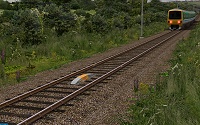  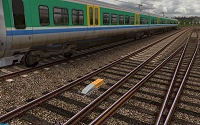 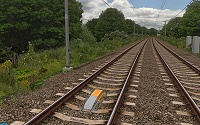 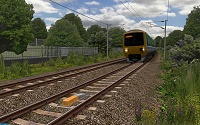 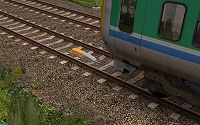 |
Also, here are some examples of full AWS permanent and electromagnet installations on the Watford Junction to Rugby route:
 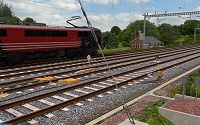 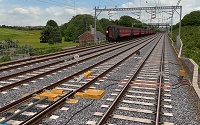 |
West Coast Main Line Video
![]() Lastly, anyone with an interest in the real West Coast Main Line, might like to take a look at a video which I uploaded to YouTube recently, which features the Old Linslade and Leighton Buzzard areas – two locations I’m modelling in my representation of the Watford Junction to Rugby section of the WCML. Those of you who noticed or commented on the Train Operated Warning System I demonstrated in my last openBVE video (the rotating orange lights with audible warnings), can now watch the real system in action.
Lastly, anyone with an interest in the real West Coast Main Line, might like to take a look at a video which I uploaded to YouTube recently, which features the Old Linslade and Leighton Buzzard areas – two locations I’m modelling in my representation of the Watford Junction to Rugby section of the WCML. Those of you who noticed or commented on the Train Operated Warning System I demonstrated in my last openBVE video (the rotating orange lights with audible warnings), can now watch the real system in action.
This footage was filmed in October 2004 to assist me with developing this part of the route (only in standard definition unfortunately), but you’ll see a couple of class 87s which were still in service at the time. Also featured, are ubiquitous Pendolinos, class 321 EMUs, as well as classes 58, 60 and 66 diesels, and class 90 and 92 25kV AC electric locos. Don’t forget to change to 480p resolution for the best image quality.
And finally…
Lastly, I’d just like to wish visitors a happy and peaceful Christmas, and say thanks for all the interest shown in my work so far. 🙂
Tags: Cross-City South, openBVE, Screenshots, Site News, Software, Trackwork, Watford Jn to Rugby
Posted in openBVE, Site News | 28 Comments »

